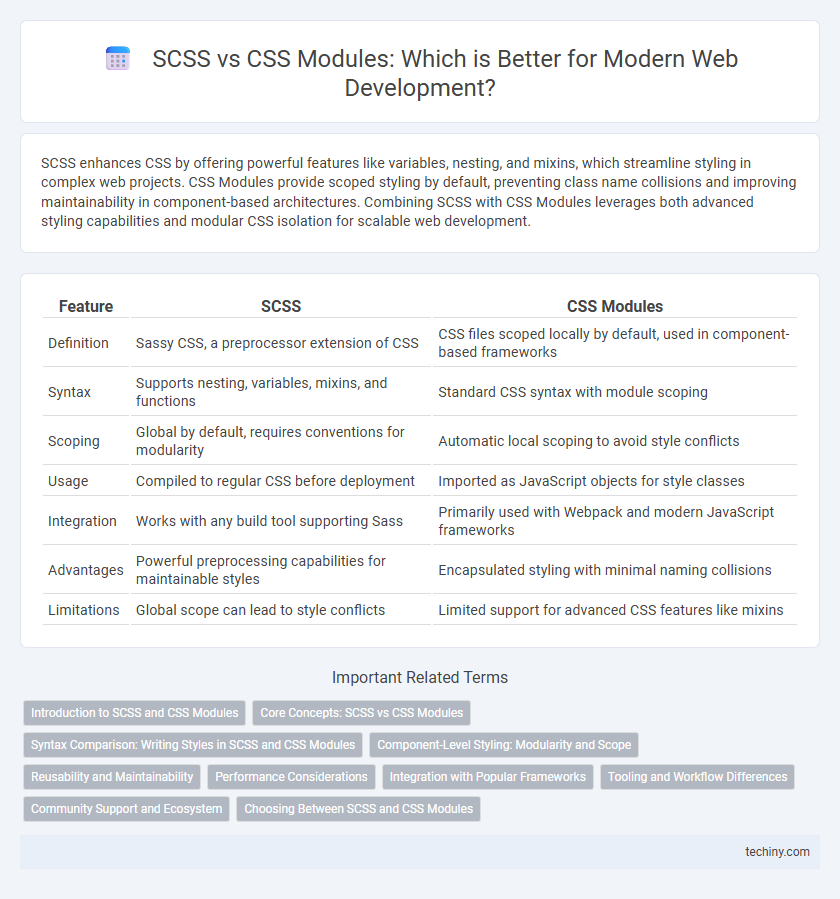SCSS enhances CSS by offering powerful features like variables, nesting, and mixins, which streamline styling in complex web projects. CSS Modules provide scoped styling by default, preventing class name collisions and improving maintainability in component-based architectures. Combining SCSS with CSS Modules leverages both advanced styling capabilities and modular CSS isolation for scalable web development.
Table of Comparison
| Feature | SCSS | CSS Modules |
|---|---|---|
| Definition | Sassy CSS, a preprocessor extension of CSS | CSS files scoped locally by default, used in component-based frameworks |
| Syntax | Supports nesting, variables, mixins, and functions | Standard CSS syntax with module scoping |
| Scoping | Global by default, requires conventions for modularity | Automatic local scoping to avoid style conflicts |
| Usage | Compiled to regular CSS before deployment | Imported as JavaScript objects for style classes |
| Integration | Works with any build tool supporting Sass | Primarily used with Webpack and modern JavaScript frameworks |
| Advantages | Powerful preprocessing capabilities for maintainable styles | Encapsulated styling with minimal naming collisions |
| Limitations | Global scope can lead to style conflicts | Limited support for advanced CSS features like mixins |
Introduction to SCSS and CSS Modules
SCSS is a powerful CSS preprocessor that extends standard CSS with nested rules, variables, and mixins, enabling more maintainable and scalable stylesheets. CSS Modules provide locally scoped CSS by generating unique class names, preventing style conflicts in component-based frameworks like React. Both tools enhance modularity and maintainability but approach styling isolation and reuse through different mechanisms.
Core Concepts: SCSS vs CSS Modules
SCSS extends CSS with variables, nested rules, and mixins, enabling more maintainable and reusable styles through a preprocessor syntax that compiles into standard CSS. CSS Modules scope class names locally by default, preventing style conflicts in component-based architectures by generating unique identifiers for each class. While SCSS enhances stylesheet syntax and organization, CSS Modules focus on modularity and encapsulation for styling React or similar component frameworks.
Syntax Comparison: Writing Styles in SCSS and CSS Modules
SCSS syntax extends CSS by allowing nested rules, variables, and mixins, enabling more modular and reusable style definitions. CSS Modules use standard CSS syntax but scope class names locally by default, preventing style conflicts through unique, hashed class identifiers. SCSS syntax promotes cleaner, DRY code with advanced features, whereas CSS Modules emphasize encapsulation using straightforward CSS structure combined with JavaScript imports.
Component-Level Styling: Modularity and Scope
SCSS enhances component-level styling by leveraging nested syntax and variables, enabling reusable, maintainable styles within components. CSS Modules provide automatic local scoping by generating unique class names, preventing style conflicts across components in large-scale React applications. Both techniques improve modularity, but CSS Modules offer stronger encapsulation ideal for isolating styles in component-driven frameworks.
Reusability and Maintainability
SCSS enables enhanced reusability through variables, mixins, and nesting, allowing developers to write modular and maintainable style sheets. CSS Modules scope styles locally by default, preventing class name collisions and promoting component-level maintainability in large React applications. Combining SCSS with CSS Modules offers a powerful approach to scalable and maintainable front-end styling architecture.
Performance Considerations
SCSS enables powerful nesting and variables but compiles into plain CSS, which may increase stylesheet size and impact load times. CSS Modules generate scoped CSS classes at build time, reducing runtime overhead and improving caching efficiency. For large-scale React applications, CSS Modules often provide better performance through isolated styles and minimized global scope pollution.
Integration with Popular Frameworks
SCSS integrates seamlessly with popular frameworks like React, Angular, and Vue through native or plugin-based support, allowing advanced features such as variables and nesting to enhance styling workflows. CSS Modules, predominantly favored in React ecosystems, provide scoped styling by default, preventing class name collisions and improving maintainability in component-based architectures. Both approaches align effectively with modern build tools like Webpack, enabling efficient bundling and modular CSS management in large-scale web applications.
Tooling and Workflow Differences
SCSS offers a powerful preprocessor tooling ecosystem that supports variables, nesting, and mixins, enabling more maintainable and expressive stylesheets within projects. CSS Modules integrate seamlessly with modern JavaScript bundlers like Webpack, providing scoped class names and automatic CSS encapsulation, which improves modularity and reduces style conflicts in component-based workflows. While SCSS requires a compilation step to convert into standard CSS, CSS Modules combine style management directly in the JavaScript build process, streamlining developer workflow in React and similar frameworks.
Community Support and Ecosystem
SCSS boasts a mature ecosystem with extensive libraries, frameworks, and a large community providing robust support, tutorials, and tools. CSS Modules benefit from growing adoption in modern JavaScript frameworks like React, offering seamless integration and modular styles but have a smaller, more specialized community. Developers choose SCSS for its powerful preprocessor features and wide ecosystem, while CSS Modules appeal due to their scoped styling and compatibility with component-based architectures.
Choosing Between SCSS and CSS Modules
Choosing between SCSS and CSS Modules depends on the project's complexity and team workflow; SCSS excels with advanced features like variables, nesting, and mixins, enhancing code maintainability and scalability. CSS Modules offer scoped styling by default, preventing global namespace conflicts and enabling modular component-based development, ideal for React ecosystems. Developers prioritize SCSS for extensive style logic and CSS Modules for isolated, reusable styles that integrate seamlessly with JavaScript frameworks.
SCSS vs CSS Modules Infographic

 techiny.com
techiny.com